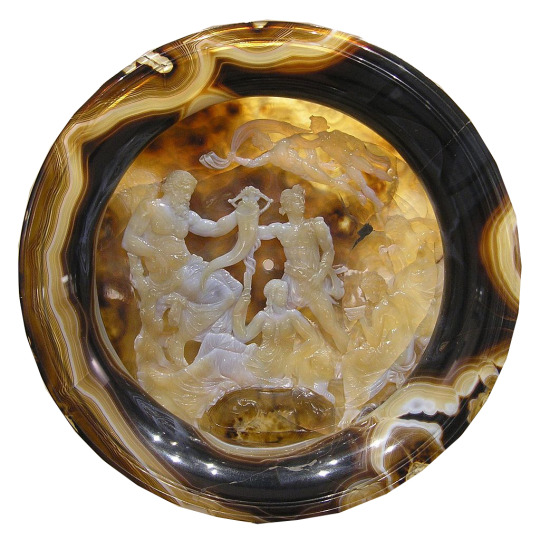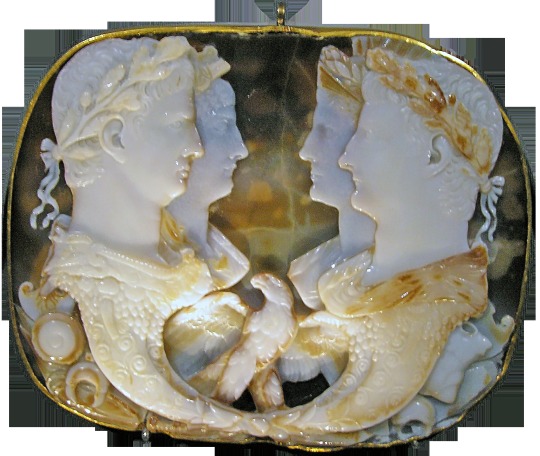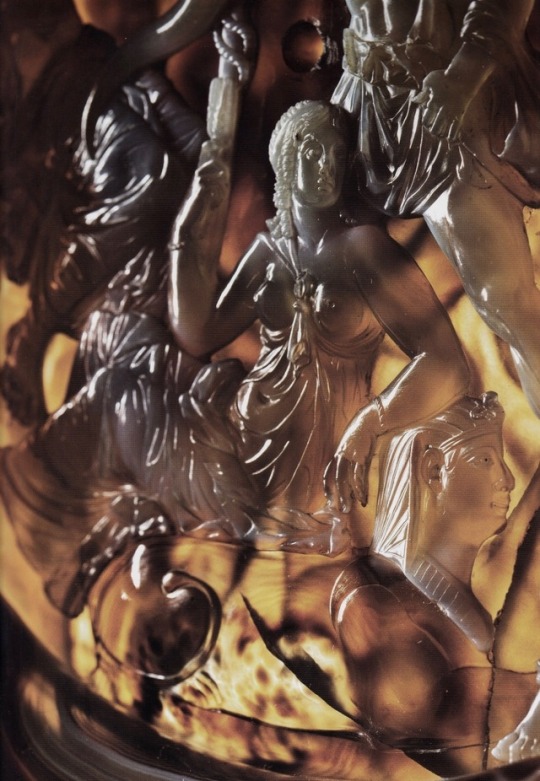#tazza farnese
Explore tagged Tumblr posts
Text
Le straordinarie Gemme Farnese
0 notes
Text

La tazza Farnese
0 notes
Text

Tazza Farnese (Museo Archeologico Nazionale di Napoli)
0 notes
Photo


La Tazza Farnese
Farnese_Cup
62 notes
·
View notes
Photo










Tazza Farnese
Valeria Sampaolo e Luigi Spina
5 Continents Editions, Milano 2018, 80 pagine, 70 ill.a colori, ISBN: 978-88-7439-834-8
euro 40,00
email if you want to buy :[email protected]
Poche altre opere del MANN rispondono alla definizione della collana «Tesori nascosti» quanto la Tazza Farnese.
Il più grande vaso in pietra dura lavorata a rilievo ci è arrivato dal mondo antico attraverso un cammino lungo secoli durante i quali, con ogni verosimiglianza, non è mai finito sottoterra: da Alessandria d’Egitto a Roma, a Costantinopoli per tornare a Roma nel XV secolo dove lo acquistò quel finissimo intenditore d’arte che fu Lorenzo de’ Medici, passando poi dalla sua collezione a quella Farnese, penultima tappa prima di fermarsi nelle raccolte dell’Archeologico.
A questa intrigante storia di passaggi da una corte all’altra la tazza unisce quella non definitivamente risolta dell’interpretazione della scena raffigurata al suo interno, spiegata in più modi e ancora argomento di nuove precisazioni. Eseguita con un abilissimo lavoro di incisione per mettere in risalto le figure dei personaggi interni e il volto terrificante della Gorgone sull’esterno, ha sfruttato tutte le variazioni di colore dell’agata sardonica.
Valeria Sampaolo è stata Conservatore Capo delle collezioni del Museo Archeologico Nazionale di Napoli. Autrice di numerose pubblicazioni, si dedica in particolare a ricerche sui primi scavi nell’area vesuviana e sulla ricostruzione dei contesti di provenienza degli affreschi del museo, dei quali ha curato la nuova esposizione.
Luigi Spina, fotografo. Al centro della sua opera sono gli anfiteatri e il senso civico del sacro, i legami tra arte e fede, la ricerca di antiche identità culturali, il confronto fisico con la scultura classica.
orders to: [email protected]
ordini a: [email protected]
twitter: @fashionbooksmi
flickr: fashionbooksmilano
instagram: fashionbooksmilano
designbooksmilano
tumblr: fashionbooksmilano
designbooksmilano
#tazza farnese#luigi spina#museo archeologico nazionale napoli#pietra dura lavorata#agata sardonica#lorenzo de'medici#tesori nascosti#photography books#libri di fotografia#fashionbooksmilano
10 notes
·
View notes
Photo

Museo Nazionale Archeologico, Napoli, Italia Tazza Farnese Collezione Farnese Glittica
#raffaello bencini#tazza farnese#glyptics#2nd-century bc#cameo#sardonyx agate#art#glittica#farnese cup#II sec ac#photography
1 note
·
View note
Text
MANN, IL MUSEO ARCHEOLOGICO NAZIONALE DI NAPOLI
Il MANN, il Museo Archeologico Nazionale di Napoli, racchiude tutta la meraviglia del mondo antico che nel Settecento ha dato vita al gusto del Neoclassicismo. A Napoli, la città che Antonio Canova, nel suo viaggio nel 1780, scrive “per tutto sono situazioni di Paradiso”, in un solo palazzo sono raccolti secoli di storia in un susseguirsi di eventi che ha consegnato i tesori del passato allo…
View On WordPress
#Antonio Canova#Artemide Efesia#Collezione Farnese#Collezione Vesuviana#Ercole Farnese#Ferdinando IV di Borbone#Johann Joachim Winckelmann#MANN#Museo Archeologico Nazionale di Napoli#Tazza Farnese#Tirannicidi#Toro Farnese#Venere di Callipigia
0 notes
Photo

The Drunken SiIenus: Design for the "Tazza Farnese" by Annibale Carracci, Drawings and Prints
Medium: Pen and brown ink, brush and brown wash, over traces of black chalk, and stylus compass constructions. Framing lines in pen and brown ink and black chalk or charcoal
Harris Brisbane Dick and Rogers Funds, 1972 Metropolitan Museum of Art, New York, NY
http://www.metmuseum.org/art/collection/search/338417
10 notes
·
View notes
Photo

The Drunken SiIenus: Design for the "Tazza Farnese" The Metropolitan Museum of Art
2 notes
·
View notes
Photo

Tazza Farnese, now in the #museoarcheologicodinapoli. It belonged once to #lorenzoilmagnifico #napoli #medicifamily #beauty #art #instaart #itsflorenceontour http://bit.ly/2SQW5FZ
0 notes
Text
IMPERIAL PORTRAIT CAMEOS










I. Techniques and Materials
The gemstones onxy and sardonyx often have veins of white onyx running through them. Cameo carving, including the so-called state portrait cameos depicting emperor, ingeniously exploits that flaw in the stone.
Following Hellenistic models (the most famous being the Tazza Farnese, seen below), the carvers cleaved the stone at a vein and, working on exposed vein, removed the white stone to varying depths around the image, to create low-relief white portraits set against dark backgrounds.

Intaglio is the opposite process, wherein the image rather than the background is carved down into the stone. The Romans excelled at this technique as well, as seen in this signet ring depicting the Lupercal.
The finest surviving Roman cameo, the Gemma Augustaea, was in all likelihood carved by Dioscurides, a Greek gem carver patronized by Augustus. The diaphonous drapery, the modeling of the body, and the overlapping of figures all worked in the same, thin white vein is a tour de force performance that was evidently beyond the ability of Roman artists at this time.

Roman artists did, however, successfully transpose the cameo technique to luxury glassware, exemplified by the Portland Vase. That technique, in turn, was adapted for Neo-classsical jasperware by Josiah Wedgewood.
II. Iconography and Audience
Cameos bearing the likeness of the emperor are often referred to a “state portrait cameos.” This nomenclature is based on two assumptions:
1) the cameos as faithful replicas of a designated, official portrait of the emperor, which disseminated across all media
2) cameo portraits fulfilled an official state function or were designed to circulate in an ideological or political context.
Although the cameos are clearly based on some kind of model, it is important to remember that there is no textual or material historical evidence of any kind of for an official portrait. If suspends the theory of a state-designated portrait, the justification for a “state” function of the cameo portraits evaporates.
Although the larger surving cameos have complex political and religious iconographies, the intimate scale and preciousness of the materials makes it difficult to imagine how they would be effectively pressed into propagandistic, ceremonial, or cult service. It seems much more likely that these carved gemstones were personal commissions or given as gifts either to by the persons depicted on them, and that they served as keepsakes, like 18th century portrait silhouettes or daguerreotypes. The program of the Gemna Augustaea, which concerns the deification of Augustus and the succession of Tiberius, addresses familial and dynastic concerns, which would have been of interest to close friends or family.
#sardonyx#onyx#cameo#intaglio#carnelian#roman gemstones#portraiture#wedgwood#portland vase#gemma augustaea#dioscurides
0 notes
Link
0 notes
